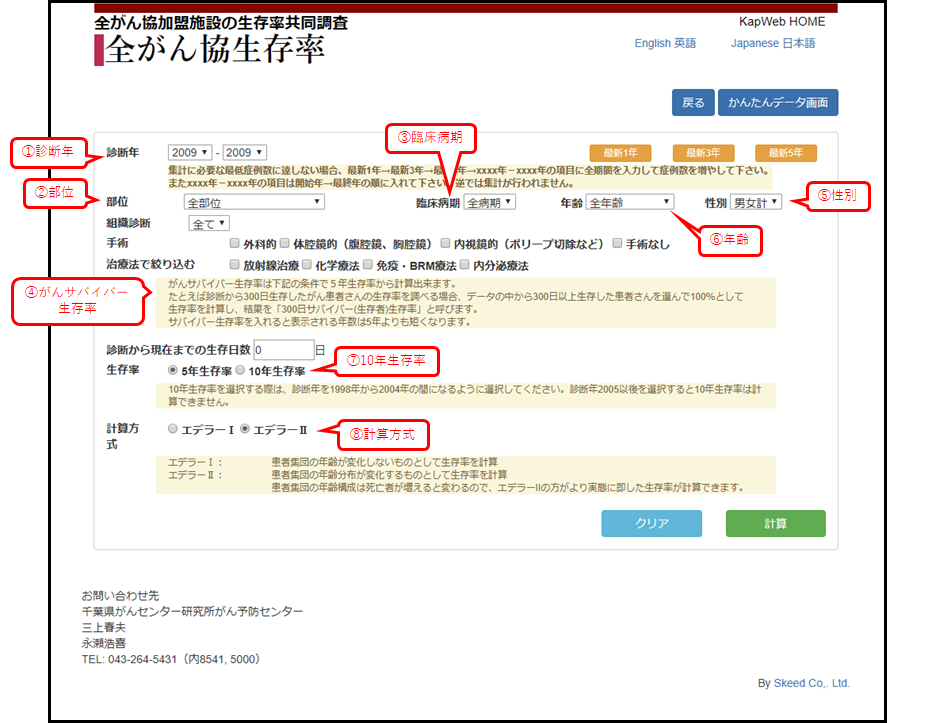【かんたんデータ画面】
このページで、部位、臨床病期、性別の各項目を選択してください。
項目を選択したら「計算」のボタンをクリックしてください。KapWebが計算を始めます。
データや選択した項目によっては、計算に時間がかかり、結果の表示までお待ちいただくことがあります。
項目を選択したら「計算」のボタンをクリックしてください。KapWebが計算を始めます。
データや選択した項目によっては、計算に時間がかかり、結果の表示までお待ちいただくことがあります。

:
この画面では7部位に限られます。お探しの部位がない場合はくわしいデータ画面で調べてみて下さい。
:
一般に性別によって生存率が異なる場合があるので、性別を入力して調べて下さい。
:
治療開始前に診断された臨床病期分類別に1期から4期まで調べることができます。手術後に得られた情報によって訂正された病期には対応していません。
【くわしいデータ画面】
この画面では、さらに詳しいデータの検索ができます。
かんたんデータ画面の項目に加えて、診断年、手術、治療法、年齢で絞り込むことができます。また、がんサバイバー生存率も算出することができます。
かんたんデータ画面の項目に加えて、診断年、手術、治療法、年齢で絞り込むことができます。また、がんサバイバー生存率も算出することができます。

:
生存率は年々向上しています。一方、診断年を絞り込むと集計に必要な症例数が少なく集計ができないことになります。
そこで「最新1年」→「最新3年」→「最新5年」の順に集計する症例数を増やして下さい。それでも不足する場合は集計年をさらに広げて下さい。
また古い集計年から新しい集計年へ5年生存率の計算を進めることで、そのがんの治療の進歩をみることができます。
そこで「最新1年」→「最新3年」→「最新5年」の順に集計する症例数を増やして下さい。それでも不足する場合は集計年をさらに広げて下さい。
また古い集計年から新しい集計年へ5年生存率の計算を進めることで、そのがんの治療の進歩をみることができます。
:
数の少ないがんでは診断年の範囲を拡大して集計する症例数を増やして下さい。
:
治療開始前に診断された臨床病期分類別に1期から4期まで調べることができます。手術後に得られた情報によって訂正された病期には対応していません。
2a期など詳細な病期(サブステージ)には対応しておりません。
2a期など詳細な病期(サブステージ)には対応しておりません。
:
まずは初診初回治療である0日で計算して下さい。
そのあとで、診断日からお知りになりたい経過日数を計算して入力して下さい。
がんの種類により、日数が経過するほど生存率が向上するがんと、日数が経過しても再発や後遺障害、別のがん発生のために生存率がなかなか向上しないがんがあることがわかります。
そのあとで、診断日からお知りになりたい経過日数を計算して入力して下さい。
がんの種類により、日数が経過するほど生存率が向上するがんと、日数が経過しても再発や後遺障害、別のがん発生のために生存率がなかなか向上しないがんがあることがわかります。
:
一般に性別によって生存率が異なる場合があるので、性別を入力して調べて下さい。
:
全がん協生存率統計では15歳から94歳までのがん症例を収集しています。
小児がんや95歳以上のがんは含まれておりませんので別途専門医にお尋ね下さい。
小児がんや95歳以上のがんは含まれておりませんので別途専門医にお尋ね下さい。
:
5年生存率に加え、1998年から2005年にがんと診断された患者の10年生存率も算出できるようになりました。
:
生存率の計算方法をエデラーⅠ法とエデラーⅡ法で選択できるようにしました(くわしいデータ画面)。
エデラーⅠ法は、患者集団の年齢が変化しないものとして生存率を計算、エデラーⅡ法は、患者集団の年齢分布が変化するものとして生存率を計算しております。
また、患者集団の年齢構成は死亡者が増えると変わるので、エデラーⅡの方がより実態に即した生存率が計算できます。
尚、両者の生存率は、計算方法が異なるため直接比較することはできません。
また、国によって生存率の計算方法が異なる場合がありますので、他の国の生存率とも直接比較することはできません。
エデラーⅠ法は、患者集団の年齢が変化しないものとして生存率を計算、エデラーⅡ法は、患者集団の年齢分布が変化するものとして生存率を計算しております。
また、患者集団の年齢構成は死亡者が増えると変わるので、エデラーⅡの方がより実態に即した生存率が計算できます。
尚、両者の生存率は、計算方法が異なるため直接比較することはできません。
また、国によって生存率の計算方法が異なる場合がありますので、他の国の生存率とも直接比較することはできません。
●引用ルール
全がん協生存率を引用される場合は次の通りお願いいたします。
「全国がんセンター協議会の生存率共同調査(xxxx年xx月集計)による」と記載してください。
生存率データは1年間に複数回updateされています。
また、書籍に引用の際はグラフ右側に表示されるデータ提供施設名も可能なかぎり記載してください。
●本サイトへのリンクについて
本ページへのリンクはご自由に張っていただいて結構です。
ただし、TOPページをリンク先としてください。
https://kapweb.chiba-cancer-registry.org
http://www.zengankyo.ncc.go.jp/etc/index.html(全がん協生存率調査)
全がん協生存率を引用される場合は次の通りお願いいたします。
「全国がんセンター協議会の生存率共同調査(xxxx年xx月集計)による」と記載してください。
生存率データは1年間に複数回updateされています。
また、書籍に引用の際はグラフ右側に表示されるデータ提供施設名も可能なかぎり記載してください。
●本サイトへのリンクについて
本ページへのリンクはご自由に張っていただいて結構です。
ただし、TOPページをリンク先としてください。
https://kapweb.chiba-cancer-registry.org
http://www.zengankyo.ncc.go.jp/etc/index.html(全がん協生存率調査)